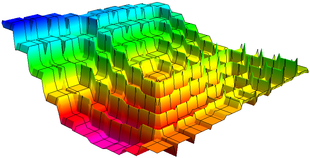10-327/Homework Assignment 4
| ||||||||||||||||||||||||||||||||||||||||||||||||||||||||||||
Reading
Read sections 23 through 25 in Munkres' textbook (Topology, 2nd edition). Remember that reading math isn't like reading a novel! If you read a novel and miss a few details most likely you'll still understand the novel. But if you miss a few details in a math text, often you'll miss everything that follows. So reading math takes reading and rereading and rerereading and a lot of thought about what you've read. Also, preread sections 26 through 27, just to get a feel for the future.
Doing
Solve and submit problems 1-3 and 8-10 Munkres' book, pages 157-158.
Due date
This assignment is due at the end of class on Monday, October 25, 2010.
Suggestions for Good Deeds
Annotate our Monday videos (starting with Video: ![]() Topology-100927) in a manner similar to (say)
Topology-100927) in a manner similar to (say) ![]() AKT-090910-1, and/or add links to the blackboard shots, in a manner similar to
AKT-090910-1, and/or add links to the blackboard shots, in a manner similar to ![]() Alekseev-1006-1. Also, make constructive suggestions to me, Dror and / or the videographer, Qian (Sindy) Li, on how to improve the videos and / or the software used to display them. Note that "constructive" means also, "something that can be implemented relatively easily in the real world, given limited resources".
Alekseev-1006-1. Also, make constructive suggestions to me, Dror and / or the videographer, Qian (Sindy) Li, on how to improve the videos and / or the software used to display them. Note that "constructive" means also, "something that can be implemented relatively easily in the real world, given limited resources".
| Dror's notes above / Student's notes below |
Questions
1)Hi, quick question. I am wondering if the term test will cover the material on this assignment, or only the material before the assignment. Thanks! Jason.
2) In EXAMPLE 7 on page 151 Munkres claims that Rn~ is ['clearly' :)] homeomorphic to Rn: where Rn~ consists of all sequences x=(x1,x2,x3,...) with xi=0 for i>n, and Rn consists of all sequences x=(x1,x2,...xn). Why are they homeomorphic ?? Thank you kindly. Oliviu.
RE: 2) Let be defined as and let be defined as where if and otherwise. Then both and are continuous, because we are working in the product topology and the component functions, namely the projection function and constant function are continuous. Also is a bijection because and , i.e has a left and right inverse. So is a homeomorphism between the two spaces. Quick question is there a nicer way of writing math than using the math tag? Ian 16:03, 22 October 2010 (EDT)
3)Question. Suppose we have a function f going from topological space X to Y which is not onto and a function g going from Y to Z. Could I still define the composition of f and g? i.e. g circle f? -Kai Xwbdsb 19:19, 22 October 2010 (EDT)
- If I understand your question, I don't see why not...think about for example. is not onto, then let then g compose f is - John
- I agree but look at munkre's page 17 last sentence. Note that g compose with f is defined only when the range of f equals the domain of g. So I just want to confirm with Dror if there is something wrong here.
- Touche, I see your point...that is strange - John
- I agree but look at munkre's page 17 last sentence. Note that g compose with f is defined only when the range of f equals the domain of g. So I just want to confirm with Dror if there is something wrong here.
4)Question about the proof for [0,1] being connected. A few details are omitted. why would a closed subset of [0,1] contain its supremum? Also why [0,g_0] being a subset of A follows automatically after we showed that g_0 is in A? -Kai
- 1. Suppose is closed in is open. If s.t. is an upper bound for S.
- 2. Recall that . So, if . -Frank Fzhao 23:50, 22 October 2010 (EDT)
- Thanks Frank. But I don't think your solution is convincing enough. \alpha - 0.5r is indeed not in S but why can you say it is an upper bound for S? Remember S could be rather complicated set all you know is that it is closed.
for 2 why is \Rightarrow \forall g < g_0, [0,g]? even if g_0 is sup(G) that does not mean anything less than g_0 would be in G. Consider [0,1] union {3}.
- Well, for the first question, not only is not in S, but neither is anything in , since is open. There can be no elements in S because it's the supremum. Recall also we're working in the Reals.
- For the second question, notice that the supremum is the least upper bound (of G), so , take
- Perhaps (I'm guessing here) you might have found supremum to be a confusing notion. If this is the case, have no fear, there's a chapter on supremum in Spivak's book Calculus. You can probably find one in the math library. - Frank Fzhao 09:58, 23 October 2010 (EDT)

![{\displaystyle [0,1]}](https://wikimedia.org/api/rest_v1/media/math/render/svg/738f7d23bb2d9642bab520020873cccbef49768d)




















![{\displaystyle [0,1].\Rightarrow S^{C}}](https://wikimedia.org/api/rest_v1/media/math/render/svg/40296f0be71ab2649c274f8562a7f7d2108dd2c2)



![{\displaystyle G=\{g|[0,g]\subset A\};g_{0}=sup(G)\Rightarrow \forall g<g_{0},[0,g]\subset A\Rightarrow [0,g_{0})\subset A}](https://wikimedia.org/api/rest_v1/media/math/render/svg/74a1651afe056f8fa4a66764332e04c836085847)
![{\displaystyle g_{0}\in A\Rightarrow [0,g_{0}]\subset A}](https://wikimedia.org/api/rest_v1/media/math/render/svg/d445e379ca5d74d40f910617dcb4e8439ac7d9ab)





![{\displaystyle \forall r>0,\exists g\in G\cap B(g_{0},r)\Rightarrow [0,g]\subset A\Rightarrow [0,g']\subset A,\forall g'<g\Rightarrow g'\in G\Rightarrow \forall g<g_{0}}](https://wikimedia.org/api/rest_v1/media/math/render/svg/c99f65aeeaac36f841050086d4128e4fe9f95890)
![{\displaystyle r=0.5(g_{0}-g)\Rightarrow \exists a\in (g_{0}-r,g_{0})\cap G,\Rightarrow [0,g]\subset [0,a]\subset A.}](https://wikimedia.org/api/rest_v1/media/math/render/svg/d44464ac7b9da166664d54ace8bef8480b8c1985)